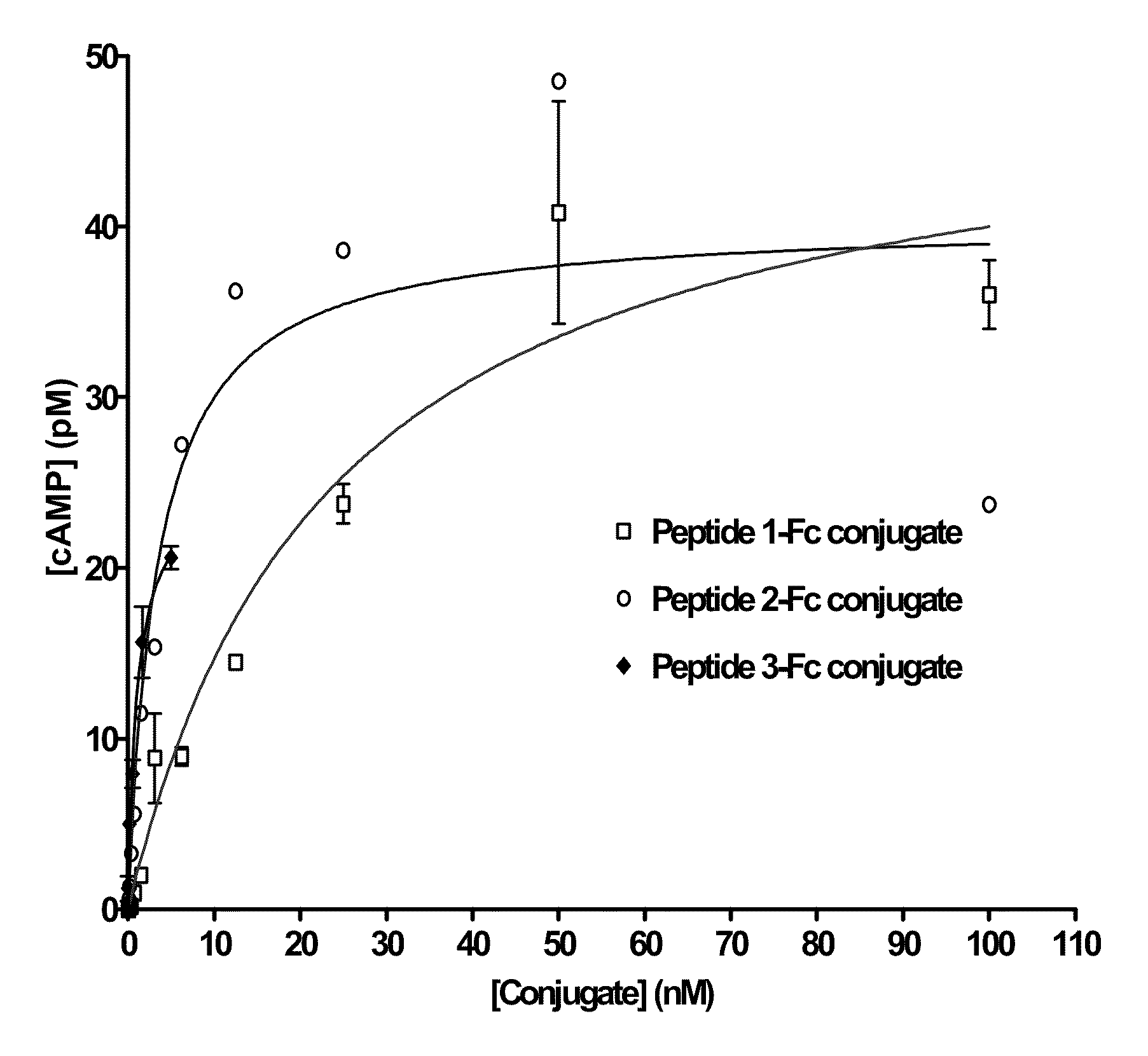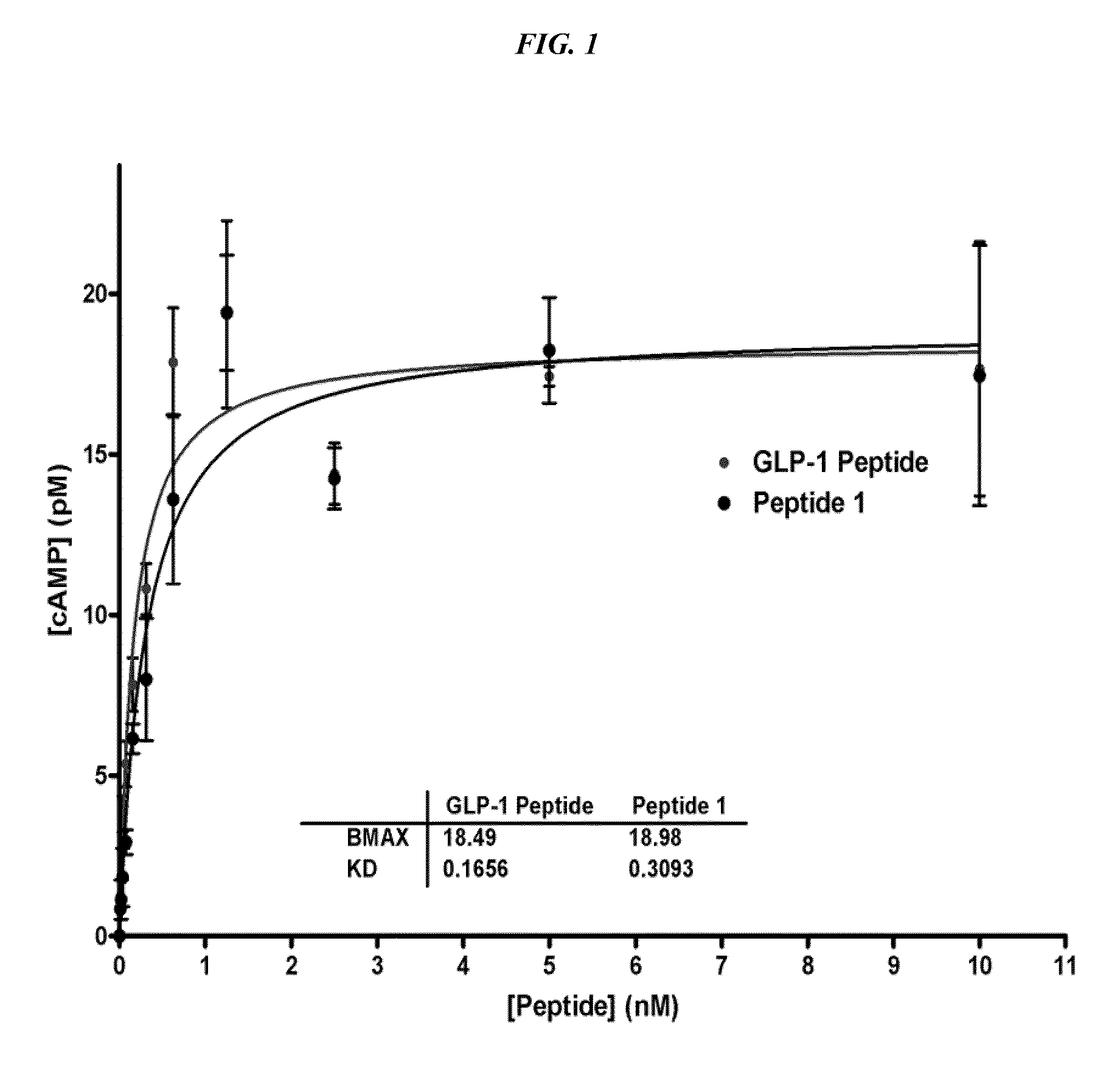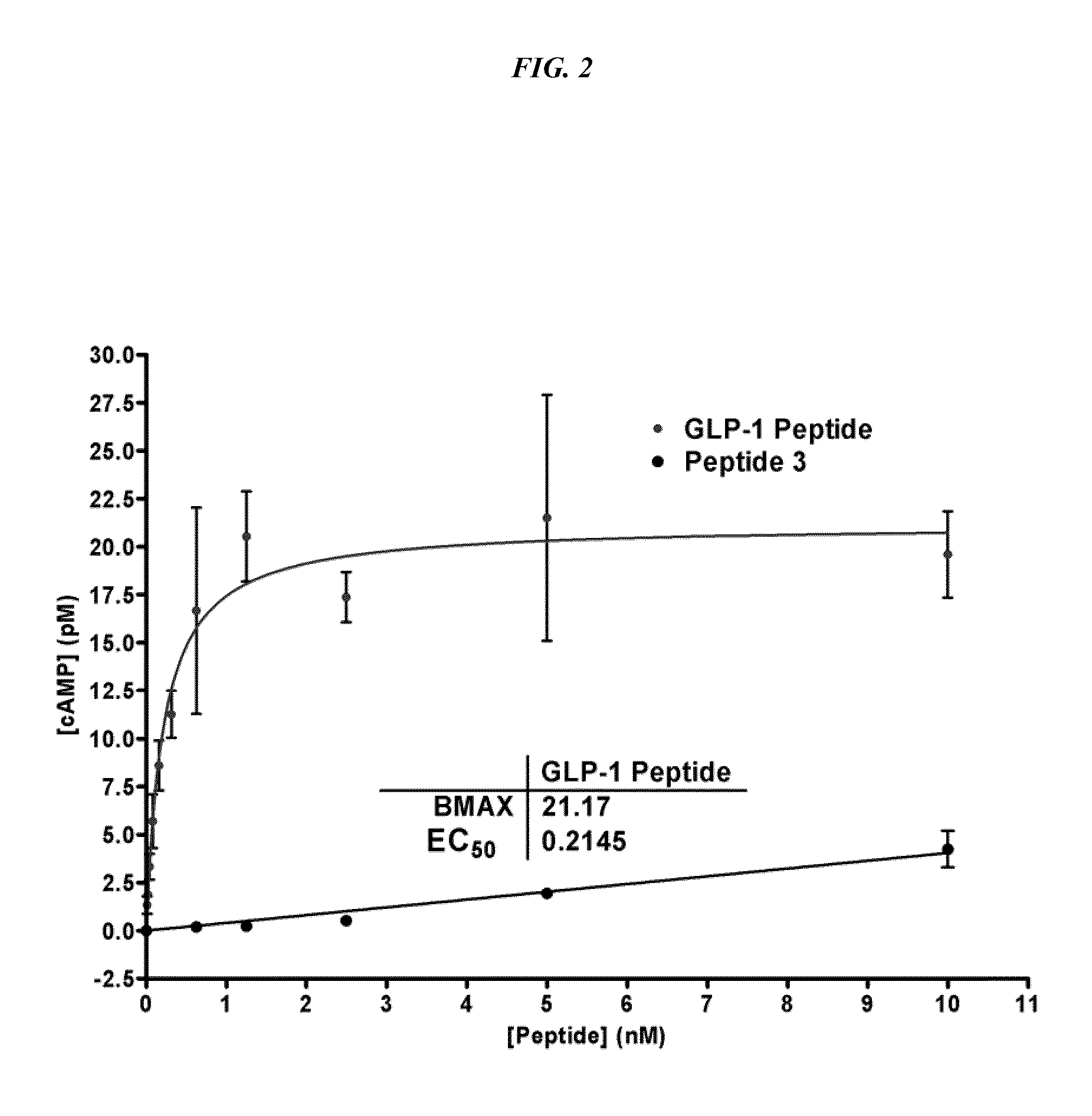Semi-Synthetic GLP-1 Peptide-FC Fusion Constructs, Methods and Uses
a fusion construct and glp-1 technology, applied in the field of bioactive peptides, can solve the problems of prolonging the time until, unable to cure the disease, and reducing the biological activity of the molecule, so as to increase the serum half-life of the molecule and reduce the biological activity
- Summary
- Abstract
- Description
- Claims
- Application Information
AI Technical Summary
Benefits of technology
Problems solved by technology
Method used
Image
Examples
example 1
Preparation of Activated GLP-1 Peptides
Example 1A
(His-[D-Ala]-Glu-Gly-Thr-Phe-Thr-Ser-Asp-Val-Ser-Ser-Tyr-Leu-Glu-Gly-Gln-Ala-Ala-Lys-Glu-Phe-Ile-Ala-Trp-Leu-Val-Lys-Gly-Arg-Gly-(N-3-aminopropyl)-PEG3—NH—CO—CH2—NH—NH2)
[0112]A GLP-1 (7-36, NH2) analog peptide containing a D-Ala substitution in the second residue as previously described (Siegel, et al. 1999 Regulatory Peptides 79:93-102) was synthesized and activated (Peptide 1).
[0113]The peptide was prepared on an ABI 433A Peptide Synthesizer using SynthAssist 2.0 Version for Fmoc / HBTU chemistry by the Fastmoc 0.25 mM Monitoring Previous Peak software. Universal PEG NovaTag resin (549 mg, 252 mmol) was used in the synthesis. Fmoc-Phe-Thr(YMe, MePro)-OH was used for the sixth and seventh amino acid position in the sequence. Fmoc-Ser(But)-Ser(YMe, MePro)-OH was used for the eleventh and twelfth amino acid position in the sequence. The final weight of the resin was 1.18 g.
[0114]The resin was washed 3×2 min with ethanol and 3×2 min with ...
example 1b
(His-[D-Ala]-Glu-Gly-Thr-Phe-Thr-Ser-Asp-Val-Ser-Ser-Tyr-Leu-Glu-Gly-Gln-Ala-Ala-Lys-Glu-Phe-Ile-Ala-Trp-Leu-Val-Lys-Gly-Arg-Gly-NH—CH2-CH2-(O—CH2—CH2)12—CO-Gly-NH—NH2)
[0118]The GLP-1 (7-36, NH2) analog peptide containing a 2 D-Ala as above was used to prepare an alternatively activated reagent, Peptide 2.
[0119]The peptide was prepared on an ABI 433A Peptide Synthesizer using SynthAssist 2.0 Version for Fmoc / HBTU chemistry by the Fastmoc 0.1 mM Monitoring Previous Peak software. Fmoc-Gly-SASRIN resin (139 mg, 110 mmol) was used in the synthesis. Fmoc-Phe-Thr(YMe,MePro)-OH was used for the sixth and seventh amino acid position in the sequence. Fmoc-Ser(But)-Ser(YMe,Mepro)-OH was used for the eleventh and twelfth amino acid position in the sequence.
[0120]For the linking moiety, O—(N-Fmoc-2-aminoethyl)-0′-(2-carboxyethyl)-undecaethyleneglycol was used in the thirty-second amino acid position in the sequence The resin was washed with ethanol and dried overnight under reduced pressure. T...
example 1c
(NH2—NH—CH2—CO—NH—CH2—CH2—O—(CH2—CH2—O)10—CH2—CH2—O—CH2—CH2—CO—His-[D-Ala]-Glu-Gly-Thr-Phe-Thr-Ser-Asp-Val-Ser-Ser-Tyr-Leu-Glu-Gly-Gln-Ala-Ala-Lys-Glu-Phe-Ile-Ala-Trp-Leu-Val-Lys-Gly-Arg-Gly-NH2)
[0123]The GLP-1 (7-36, NH2) analog peptide containing a 2 D-Ala as above was used to prepare an alternatively activated reagent, Peptide 3.
[0124]The peptide was prepared on an ABI 433A Peptide Synthesizer using SynthAssist 2.0 Version for Fmoc / HBTU chemistry by the Fastmoc 0.25 mM Monitoring Previous Peak software. Rink resin (833 mg, 250 mmol) was used in the synthesis. Fmoc-Gly-Thr(YMe, MePro)-OH, Fmoc-Phe-Thr(YMe, MePro)-OH and Fmoc-Val-Ser(YMe, MePro)-OH were used for the 21st, 23rd and 24th positions respectively. O—(N-Fmoc-2-aminoethyl)-0′-(2-carboxyethyl)-undecaethyleneglycol was used in the 28th position and tri-Boc-hydrazinoacetic acid was used in the 29th position. The final weight of the resin was 1.74 g. The peptide was simultaneously deprotected and removed from the resin with a...
PUM
| Property | Measurement | Unit |
|---|---|---|
| flexible | aaaaa | aaaaa |
| pharmaceutical composition | aaaaa | aaaaa |
| bioactive | aaaaa | aaaaa |
Abstract
Description
Claims
Application Information
 Login to View More
Login to View More - R&D
- Intellectual Property
- Life Sciences
- Materials
- Tech Scout
- Unparalleled Data Quality
- Higher Quality Content
- 60% Fewer Hallucinations
Browse by: Latest US Patents, China's latest patents, Technical Efficacy Thesaurus, Application Domain, Technology Topic, Popular Technical Reports.
© 2025 PatSnap. All rights reserved.Legal|Privacy policy|Modern Slavery Act Transparency Statement|Sitemap|About US| Contact US: help@patsnap.com



